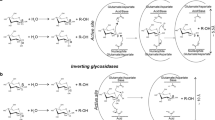Abstract
A new mannose-recognizing lectin (MOL) was purified on an asialofetuin-column from fruiting bodies of Marasmius oreades grown in Japan. The lectin (MOA) from the fruiting bodies of the same fungi is well known to be a ribosome-inactivating type lectin that recognizes blood-group B sugar. However, in our preliminary investigation, MOA was not found in Japanese fruiting bodies of M. oreades, and instead, MOL was isolated. Gel filtration showed MOL is a homodimer noncovalently associated with two subunits of 13 kDa. The N-terminal sequence of MOL was blocked. The sequence of MOL was determined by cloning from cDNA and by protein sequencing of enzyme-digested peptides. The sequence shows mannose-binding motifs of bulb-type mannose-binding lectins from plants, and similarity to the sequences. Analyses of sugar-binding specificity by hemagglutination inhibition revealed the preference of MOL toward mannose and thyroglobulin, but asialofetuin was the strongest inhibitor of glycoproteins tested. Furthermore, glycan-array analysis showed that the specificity pattern of MOL was different from those of typical mannose-specific lectins. MOL preferred complex–type N-glycans rather than high-mannose N-glycans.




Similar content being viewed by others
Abbreviations
- GNA:
-
Galanthus nivalis agglutinin
- LDL:
-
Lyophyllum descades lectin
- MOA:
-
Marasmius oreades agglutinin
- MOL:
-
Marasmius oreades lectin
- RVL:
-
Remusatia vivipara lectin
- TxcL1:
-
Tulipa hybrid lectin 1 with complex specificity
References
Sharon, N., Lis, H.: Lectins as cell recognition molecules. Science 246, 227–246 (1989)
Singh, R.S., Bhari, R., Kaur, H.P.: Mushroom lectins: Current status and future perspectives. Crit. Rev. Biotechnol. 30, 99–126 (2010)
Goldstein, I.J., Winter, H.C.: Mushroom Lectins. In: Kamerling, J.P. (ed.) Comprehensive glycoscience, vol. 3, pp. 601–621. Elsevier, Amsterdam (2007)
Goldstein, I.J., Winter, H.C., Aurandt, J., Confer, L., Adamson, J.T., Hakansson, K., Remmer, H.: A new α-galactosyl-binding protein from the mushroom Lyophyllum descastes. Arch. Biochem. Biophys. 467, 268–274 (2007)
Fouquaert, E., Hanton, S.L., Balzarini, F., Peumans, W.J., Van Damme, E.J.M.: Localization and topogenesis studies of cytoplasmic and vacuolar homologs of the Galanthus nivalis agglutinin. Plant Cell Physiol. 48, 1010–1021 (2007)
Liu, Q., Wang, H., Ng, T.B.: First report of a xylose-specific lectin with potent hemagglutinating, antiproliferative and anti-mitogenic activities from a wild ascomycete mushroom. Biochim. Biophys. Acta 1760, 1914–1919 (2006)
Kruger, R.P., Winter, H.C., Simonson-Leff, N., Stuckey, J.A., Goldstein, I.J., Dixon, J.E.: Cloning, expression, and characterization of the Galα1,3Gal high affinity lectin from the mushroom Marasmius oreades. J. Biol. Chem. 277, 15002–150005 (2002)
Yagi, F., Sakai, T., Shiraishi, N., Yotsumoto, M., Mukoyoshi, R.: Hemagglutinins (lectins) in fruit bodies of Japanese higher fungi. Mycoscience 41, 323–330 (2000)
Schagger, H., Jagow, G.V.: Tricine-sodium dodecyl sulfate-polyacrylamide gel electrophoresis for the range from 1 to 100 kDa. Anal. Biochem. 166, 368–79 (1978)
Hewick, R.M., Hunkapiller, M.W., Hood, L.E., Dreyer, W.J.: A gas-liquid phase peptide and protein sequenator. J. Biol. Chem. 256, 7990–7997 (1981)
Saitou, N., Nei, M.: The neighbor-joining method: a new method for reconstructing phylogenetic trees. Mol. Biol. Evol. 4, 406–425 (1987)
Lowry, O.H., Rosebrough, N.J., Farr, A.L., Randall, R.J.: Protein measurement with the folin phenol reagent. J. Biol. Chem. 193, 256–275 (1951)
Tateno, H., Mori, A., Uchiyama, N., Yabe, R., Iwaki, J., Shikanai, Y., Angata, T., Narimatsu, H., Hirabayashi, J.: Glycoconjugate microarray based on an evanescent-field fluorescence-assisted detection principle for investigation of glycan-binding proteins. Glycobiology 18, 789–798 (2008)
Van Damme, E.J.M., Nakamura-Tsuruta, S., SMITH, D.F., Ongenaert, M., Winter, H.C., Rouge, P., Goldstein, I.J., Mo, H., Kominami, J., Culerrier, R., Barre, A., Hirabayashi, J., Peumans, W.J.: Phylogenetic and specificity studies of two-domain GNA-related lectins: generation of multispecificity through domain duplication and divergent evolution. Biochem. J 404, 51–61 (2007)
Peumans, W.J., Barre, A., Bras, J., Rougé, P., Proost, P., Van Damme, E.J.M.: The liverwort contains a lectin that is structurally and evolutionary related to the monocot mannose-binding lectins. Plant Physiol. 129, 1054–1065 (2002)
Fouquaert, E., Peumans, W.J., Gheysen, G., Van Damme, E.J.M.: Identical homologs of the Galanthus nivalis agglutinin in Zea mays and Fusarium verticillioides. Plant Physiol. Biochem. 49, 46–54 (2011)
Van Damme, E.J.M., Smeets, K., Engelborghs, I., Aelbers, H., Balzarini, J., Pusztai, A., Leuven, F., Goldstein, I.J., Peumans, W.J.: Cloning and characterization of the lectin cDNA clones from onion, shallot and leek. Plant Mol. Biol. 23, 365–376 (1993)
Van Damme, E.J.M., Lannoo, N., Peumans, W.J.: Plant lectins. Adv. Bot. Res. 48, 107–209 (2008)
Van Damme, E.J.M., Kaku, H., Perini, F., Goldstein, I.J., Peeters, B., Yagi, F., Decock, B., Peumans, W.J.: Biosynthesis, primary structure and molecular cloning of snowdrop (Galanthus nivalis L.) lectin. Eur. J. Biochem. 202, 23–30 (1991)
Bhat, G.G., Shetty, K.N., Nagre, N.N., Neekhra, V.V., Lingaraju, S., Bhat, R.S., Inamdar, S.R., Suguna, K., Swamy, B.M.: Purification, characterization and molecular cloning of a monocot mannose-binding lectin from Remusatia vivipara with nematicidal activity. Glycoconj. J. 27, 309–320 (2010)
Elo, J., Estola, E., Malmstrom, N.: On phytoagglutinins present in mushrooms. Ann. Med. Exp. Fenn. 29, 297–308 (1951)
Elo, J., Estola, E.: Phytoagglutinins present in Marasmius oreades. Ann. Med. Exp. Biol. Fenn. 30, 165–167 (1952)
Author information
Authors and Affiliations
Corresponding author
Rights and permissions
About this article
Cite this article
Shimokawa, M., Fukudome, A., Yamashita, R. et al. Characterization and cloning of GNA-like lectin from the mushroom Marasmius oreades . Glycoconj J 29, 457–465 (2012). https://doi.org/10.1007/s10719-012-9401-6
Received:
Revised:
Accepted:
Published:
Issue Date:
DOI: https://doi.org/10.1007/s10719-012-9401-6




